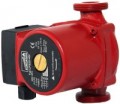Max. flow
The maximum flow of a pump is the amount of liquid it can pump in a certain amount of time.
Features of choosing the optimal performance option depend primarily on the purpose of the pump (see above). For example, for DHW recirculation models, the pump performance should not exceed the performance of the water heater. If the water heater is capable of delivering 10 litres per minute to the DHW circuit, then the maximum pump performance will be 10*60=600 L/h. The basic formula for calculating the performance of a heating system takes into account the power of the heater and the temperature difference at the inlet and outlet, and for the cold water system — the number of points of water intake. More detailed information about the calculations for each application can be found in special sources, and it is better to entrust the calculations themselves to professionals.
Minimum fluid temperature
The lowest fluid temperature at which the pump is capable of operating normally.
Almost all pumps can normally transfer cool water, regardless of the purpose (see above); therefore, for normal household use, this parameter is not critical and for some models, it may not be indicated at all. But if you need the ability to work with liquids with temperatures below 15 °C, you should pay close attention to the minimum temperature. Some models that can be used with antifreeze normally tolerate even temperatures below zero.
Insulation class
The heat resistance class of the insulating materials used in the construction of the pump. The higher the heat resistance — the more reliable the device, the less likely it is to ignite or break the insulation in case of overload or overheating. In addition, powerful performant units can become very hot even in normal operations.
In modern pumps, mainly the following classes of insulation are found:
— B. Materials with a heating limit of 130 °C. They are the most modest option by the standards of pumps. Use binding and impregnating compositions of organic origin.
— F. For this class, the heating limit is 155 °C — the average for pumps. Such insulation uses mainly synthetic binders.
— H. Insulating materials based on organosilicon binders/impregnators. Due to this, their heat resistance reaches 180 °C.

